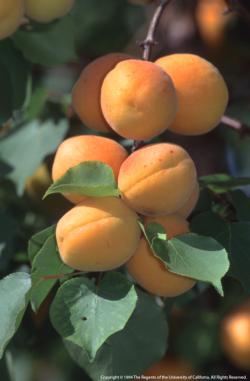Apricots, growing
-

When to plant
Bare-root and transplants
Plant bare-root trees and transplants during winter or early spring while the tree is dormant. Apricots bloom in February and early March. Because of this early blooming habit, avoid planting where late spring frost occurs to avoid light crops due to flower damage.
How to plant
Fruit trees require full sun to produce good crops. Apricots perform best in climates with dry spring weather.
Bare-root
Do not let the tree dry out before planting. Protect the roots - keep roots covered in wet peat moss or similar material - keep the tree in a cool shady place until ready to plant. When ready to plant, remove the packing from the root system, remove broken or decayed roots and then soak the roots in cool water for about 6 to 12 hours.
Plant the tree in well-draining soil, either in a raised bed or on a mound to prevent water from pooling at the roots. Soggy soil conditions lead to root diseases.
The hole should be about 1.5 to 2 feet wide and about 1.5 feet deep. Place the tree in the hole, being careful to gently spread out the roots. Refill the hole with native soil; avoid amendments and fertilizers. Be sure the graft union is about 2 inches above the soil line. Water thoroughly.
Transplants
Plant in winter or early spring in well-draining soil. Plant in native soil and water in well; fertilizers are generally not needed the first year.Read more about planting apricot trees.
Water
Apricot trees need regular irrigation during the growing season to ensure the soil is consistently and evenly moist. This is important for young trees, especially during the first year when the root system is developing. Young trees may need up to 3 to 5 gallons of water per week.
Avoid frequent light watering with sprinklers as this creates a shallow root system. A garden hose, soaker hose, or drip system can provide good deep watering. Sandy soils may have to be watered every 3 to 5 days; heavier soils may need to be watered every 1.5 to 2 weeks. During hot weather, young trees may need to be watered more often. Avoid soggy soil.
Established trees
Do not water established trees near the trunk and lower branches, as this promotes root and crown disease. Water plants around the drip line and beyond. Avoid overhead sprinklers. Water deeply and infrequently (every 2 to 3 weeks) by irrigating for 12 to 24 hours to wet to a 3- to 6-foot depth. If using a drip system, water more on a continual basis.
Reduce water in late summer and fall as the tree approaches dormancy.Read more about watering apricot trees.
Fertilizer
As a general rule, nitrogen should be applied annually, usually during the growing season. Use a balanced fertilizer in the spring, and fall, but reduce the amount of nitrogen once fruit begins to form and during fruit maturation. Excessive nitrogen can cause softer fruit, poor fruit color, and reduced storage and shelf life; it can also increase problems with numerous pests. Zinc is also commonly deficient. Affected trees have small new leaves. This deficiency is best corrected by spray applications. Spray with a "chelated zinc" during the growing season. Repeat if new growth still shows deficiency symptoms.
Apply fertilizer well away from trunk and water in well.
Thinning
Apricots usually set more fruit than they can successfully carry, so fruit thinning is essential. If you allow heavy fruiting one year, you may get little or no fruit the following year; this is known as "alternate bearing." Thin the fruits 4 to 6 inches apart on the branch when they are about an inch in diameter. Focus on damaged fruit first. Then remove fruit at the end of branches that may be weakened by heavy fruit.
Read more about thinning apricots.
Growing in containers
Dwarf apricot trees are available that can be grown in a large container or small garden space. However, check to be sure that the chill hour requirement of the dwarf variety meets your environment. Use good quality, well draining potting soil. The tree will need a sunny location, preferably a minimum of 6 hours of sun per day. Water so that the soil is evenly moist but never soggy. Fertilize more frequently than trees grown in the ground, but avoid nitrogen-rich fertilizer during the summer months.
Standard trees can be pruned and maintained at a convenient size.
Read more information about pruning.Read more about apricot trees.

